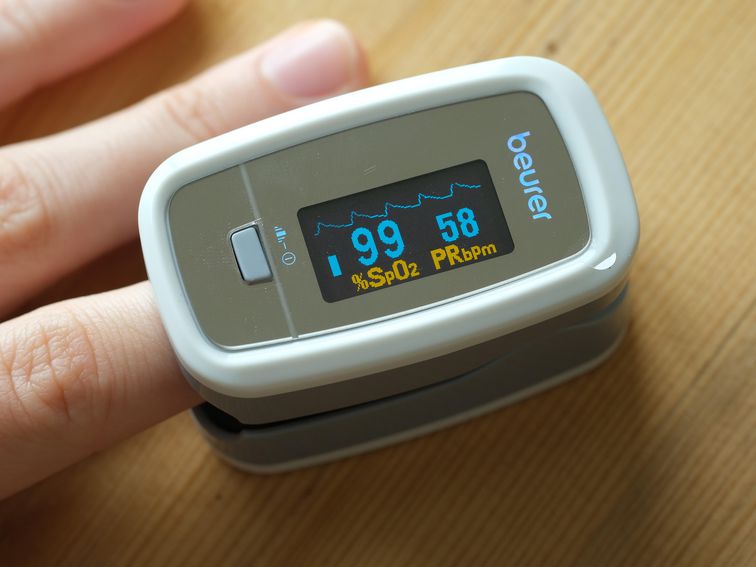
A pulse oximeter attaches to a finger and uses light to detect the level of oxygen in your blood.
Sean Gallup/Getty Images
For the most up-to-date news and information about the coronavirus pandemic, visit the WHO website.
As coronavirus testing efforts continue to ramp up and face masks become part of everyday life, a tiny diagnostic tool that clips to your finger is quickly becoming a must-have gadget in the fight against COVID-19. It’s called a pulse oximeter, and it checks your blood oxygen level.
The device was already beginning to surge in popularity as the public learned that people with the coronavirus often arrive at the hospital with abnormally low oxygen levels. After an op-ed piece in The New York Times on April 20 recommended that pulse oximeters be used to identify the sickest among COVID-19 patients and detect the frightening condition known as “silent hypoxia,” sales of the devices skyrocketed. Right now, most are sold out in stores and online.
Keep track of the coronavirus pandemic.
But questions and controversy have arisen around the at-home use of pulse oximeters, which painlessly measure heart rate and oxygen levels. It’s not entirely clear if pulse oximeters can help detect a coronavirus infection or whether their widespread use can help curb the spread of COVID-19.
Whether you already have a pulse oximeter or you’re thinking about buying one, here’s what you need to know about what they do, how they work, what the results mean and how accurate they might be.

Now playing:
Watch this:
How to make your own coronavirus protective gear on a…
7: 47
Pulse oximeters: Vital signs, at your fingertips
A pulse oximeter is a small medical device that measures heart rate and blood oxygen saturation. It’s usually clipped to your finger, but it can also attach to your ear, nose, toe or forehead. Some are battery powered and provide real-time results on a small LED display on the device itself. Others connect with a wire to a separate vital sign monitor that records even more precise information about your heart rhythm, body temperature and blood pressure using other sensors connected to your body.
How pulse oximeters measure heart rate and oxygen
A pulse oximeter measures your blood oxygen saturation and heart rate by shining a light through your skin and detecting both the color and movement of your blood cells. Oxygenated blood cells are bright red, deoxygenated cells are dark red.
The pulse oximeter compares the number of bright red cells to dark red cells to calculate your oxygen saturation as a percentage. So, for example, a reading of 99% means only 1% of the blood cells in your bloodstream have been depleted of oxygen.
Every time your heart beats, it pushes your blood through your body in a quick pulse (which is why “pulse” is another word for “heart rate”). A pulse oximeter, using light, detects this movement and calculates your heart rate in beats per minute, or BPM.
What’s a healthy oxygen level and heart rate?
According to the Mayo Clinic, a normal pulse oximeter oxygen level reading is between 95% and 100%, and anything less than 90% is considered dangerously low, or hypoxic. Some doctors have reported COVID-19 patients entering the hospital with oxygen levels at 50% or below.
A normal resting heart rate is between 60 and 100 BPM. Typically, lower is better, as a slower heart rate is usually an indication of a strong cardiovascular system.
Can a pulse oximeter detect COVID-19?
Not exactly. Although many doctors report that patients with COVID-19 are presenting with dangerously low blood oxygen levels, COVID-19 isn’t the only disease that can cause such a problem. Chronic lung diseases, like COPD, asthma and other non-COVID-19 lung infections can also result in a low oxygen count.
A low oxygen reading by itself is not enough to diagnose COVID-19, but your doctor would want to know about it, especially if you notice the level decreasing over time. And if you’ve been diagnosed with COVID-19, your doctor may want you to monitor your oxygen level to determine whether your condition is worsening or improving.

Although medical professionals continue to rely on temperature checks as an indication of a coronavirus infection, many patients with COVID-19 do not have fevers.
Angela Lang/CNET
How accurate are over-the-counter pulse oximeters?
Like with any electronic equipment, not all pulse oximeters are created equal. A 2016 study of low-cost pulse oximeters concluded several inexpensive consumer-grade devices provided highly inaccurate readings.
Some pulse oximeters have been cleared by the FDA, which means they should meet FDA standards for accuracy. Note that there is a distinction between “FDA-approved” and “FDA-cleared,” with “cleared” being the less rigorous of the two. That said, Class II medical devices like pulse oximeters are usually “cleared” rather than “approved.”
You can look for pulse oximeters on the FDA-cleared list by visiting the FDA’s Premarket Notification website and searching for “pulse oximeter” in the Device Name field, with

